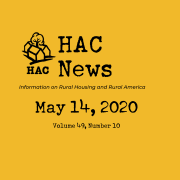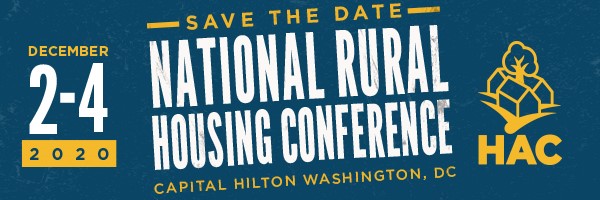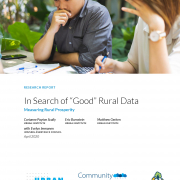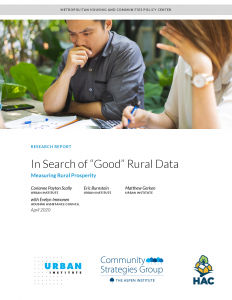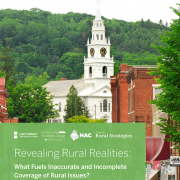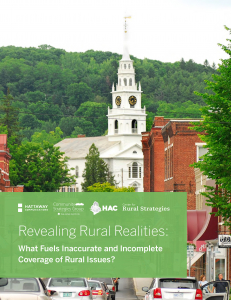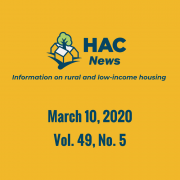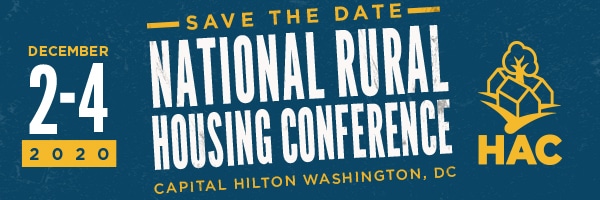HAC News: May 28, 2020
HAC News Formats. pdf
May 28, 2020
Vol. 49, No. 11
House passes another coronavirus relief bill.
On May 15 the House approved H.R. 6800, the Health and Economic Recovery Omnibus Emergency Solutions (HEROES) Act, which proposes substantial new housing assistance. The Senate is expected to work on a separate relief bill in June.
Agencies extend foreclosure moratoria and mortgage forbearance options.
In March a number of federal agencies imposed temporary bans on foreclosure for federally assisted homeowners and on evictions of both owners and renters in properties with federal aid. Some borrowers were also eligible to delay their mortgage payments. The agencies have now announced extensions through June 30, some including additional waivers or other provisions. The extensions cover mortgages backed by Fannie Mae and Freddie Mac as well as those made under USDA’s Section 502 direct program,* USDA’s Section 502 guarantee program, USDA’s Section 538 multifamily mortgage guarantee program, HUD’s Section 184 and 184A Native American and Native Hawaiian loan guarantee programs, the Department of Veterans Affairs’ loan guarantee program,and the Federal Housing Administration’s single-family loan guarantee program. ProPublica has developed a searchable database of rental properties covered by the CARES Act’s eviction ban (including those with direct or guaranteed USDA mortgages), which protects many tenants until late August. Other eviction resources are compiled on HAC’s website.
USDA offers coronavirus-related business and industry loan guarantees.
USDA’s Rural Business-Cooperative Service will guarantee almost $1 billion in loans to businesses in places with populations under 50,000. Loans must support business operations and facilities with working capital to cure problems caused by the coronavirus emergency.Eligible lenders include federal or state chartered financial institutions, Farm Credit lenders, S&Ls and others. Eligible borrowers include agricultural producers and a wide variety of entities operating rural businesses. Differences from the regular loan guarantee program include support for agricultural production, 90% guarantees, 10-year maximum terms and others. The application deadline is September 15, 2021 or whenever funds are all used. For more information, contact an RD state office. An interim final rule for the CARES Act program is effective immediately with comments due on June 22. For more information on the rule, contact Mark Brodziski, RBCS, 202-205-0903.
OCC finalizes CRA regulations, Federal Reserve and FDIC decline to join.
The Office of the Comptroller of the Currency released a final regulation to revise enforcement of the Community Reinvestment Act on May 20. The final rule retained much of the OCC’s controversial proposal, but several major elements of the initial proposal were not adopted. The rulemaking process received thousands of public comments, including a comment from HAC, which did not support the draft. Historically the three federal banking regulatory agencies have issued joint regulations but OCC’s final rule was not joined by the Federal Deposit Insurance Corporation, which had signed on to the proposal when it was released in January. The Federal Reserve Board did not join either the proposal or the final version. The National Community Reinvestment Coalition, the California Reinvestment Coalition and Democracy Forward intend to sue OCC to block its final rule. On May 21, Comptroller Joseph M. Otting announced his resignation.
June 2 webinar to explore five good ideas for rural philanthropy.
The Aspen Institute Community Strategies Group, in partnership with HAC and others, will offer a webinar titled Ratcheting Up Rural Response, Recovery and Resilience: Five Good Ideas for Philanthropy Right Now on June 2 at 2:00 pm Eastern time. Funders and rural practitioners will explore ways to provide immediate relief for the coronavirus’s impacts and to improve prospects for recovery.
Half of rural households have responded to the census, HAC reports.
A HAC analysis found that as of May 17 the rural response rate to the 2020 Census was 53%, lagging the 59.6% national rate. This Census is the first to rely primarily on online responses – a concern for rural communities given long-established internet deficiencies, household dynamics and poor connectivity in many rural markets.The coronavirus pandemic has also delayed in-person delivery of Census forms to the 5% of households, mostly rural, who do not receive them by mail. HAC encourages everyone to respond.
RuralSTAT: As of May 26, there were 121,274 reported cases of COVID-19 in counties outside of metropolitan areas, and an associated 4,600 deaths. The numbers of reported rural (outside metro) cases and deaths have more than doubled in the past 30 days. Source: Housing Assistance Council tabulations of data from the New York Times, based on reports from state and local health agencies.
President orders reducing regulations to aid economic recovery.
An Executive Order issued on May 19 directs federal agencies to temporarily or permanently rescind, modify or waive regulations in order to promote job creation and economic growth.It gives OMB the authority to oversee compliance and to issue further instructions to agencies.
SBA relief program needs changes to better aid underserved and rural businesses, say reviewers and users.
Reports by the Small Business Administration’s Inspector General and the Center for Responsible Lending have concluded that the Paycheck Protection Program created by the CARES Act did not serve disadvantaged businesses, including those in rural areas, as well as Congress intended. The IG found the SBA’s administration of the program mostly aligned with the statute but missed the mark in some ways, including not requiring lenders to prioritize underserved and rural borrowers. CRL’s analysis concluded that “structural inequities made it extremely difficult for small businesses – and particularly businesses owned by people of color – to qualify for assistance or receive it in time to save their businesses and the jobs of the employees that depend on them.” An article by Talk Poverty provides examples from California illustrating CRL’s findings. Rural participants in a recent online forum convened by a House subcommittee offered similar stories, saying the program has been helpful for rural businesses but could be even better.
H-2A farmworkers quadrupled from 2005 to 2019.
In 2005 just over 48,000 positions were certified for farmworkers with temporary H-2A visas. By 2019 more than 258,000 received certification, according to data posted by USDA’s Economic Research Service. Other farm labor data from ERS covers demographic characteristics, wages and more.
Tenants and owners of single-family homes and small buildings more likely to be economically affected by coronavirus downturn.
Noting that existing data and eviction protections tend to exclude single-family homes and small multifamily buildings, Harvard’s Joint Center for Housing Studies examined the characteristics of tenants in such homes and concluded that job losses related to the current economy could leave 20% unable to pay some or all of their rent. For larger apartment buildings the estimate is 12%. Smaller properties are also more likely to be owned by individuals who may be less able to weather a loss of rental income. JCHS did not analyze geographic differences, but HAC data tabulations show that 45% of rural renters live in single-family homes, compared to only 19% in cities and 34% in suburbs.
Recent publications and media of interest
- A Deadly ‘Checkerboard’: Covid-19’s New Surge across Rural America in the Washington Post describes the development of coronavirus hot spots in specific rural locations with limited resources.
- The Navajo Nation’s Diné College Faces the Worst Coronavirus Outbreak in the Country is a Center for American Progress article explaining how the college and its students are handling the highest per capita infection rate in the U.S. on the Navajo Nation, where 30% to 40% of residents lack running water and internet service is severely limited.
- State of Homelessness: 2020 Edition, a report from the National Alliance to End Homelessness, presents data on homelessness before the coronavirus crisis began, along withsome early predictions about the pandemic’s effect on this vulnerable population.
Need capital for your affordable housing project? HAC’s loan funds provide low interest rate loans to support single- and multifamily affordable housing projects for low-income rural residents throughout the U.S. and territories. Capital is available for all types of affordable and mixed-income housing projects, including preservation, farmworker, senior and veteran housing. HAC loan funds can be used for pre-development, site acquisition, site development and construction/rehabilitation. Contact HAC’s loan fund staff at hacloanfund@ruralhome.org, 202-842-8600.
Please note: HAC is not able to offer loans to individuals or families. Borrowers must be nonprofit or for-profit organizations or government entities (including tribes).
* The reference to the Section 502 direct program was omitted when this issue of the HAC News was originally published. The extension is noted near the bottom of USDA’s announcement. HAC apologizes for any confusion.


